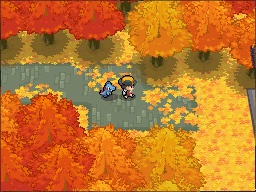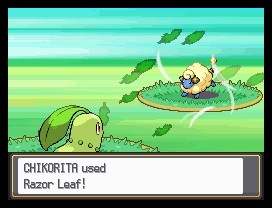It's absurd how many variations of the Pokemon role-playing games have been released since the series first hit the US in 1998. Most entries are launched in pairs with only minor differences between the two--typically in the form of unique Pokemon that must be traded between versions--and they're eventually followed up by a slightly slicker remake a few years later. What's even more ridiculous is how little these games have changed from one generation to the next, yet Poke-addicts still flock to their local gaming shops to pick up the latest version on an almost annual basis. This speaks volumes about the strength of the original concept and gameplay, but you'd think fans would reach their breaking point sooner or later. As a preventive measure, Nintendo and Game Freak have rolled out a secret weapon for their latest venture. Even though Pokemon HeartGold and SoulSilver are remakes of their 10-year-old Game Boy Color counterparts, they're the first entries in the series to actually make you want to exercise, thanks to the ingenious Pokewalker accessory that comes bundled with them. Yes, the prospect of getting up off your duff and walking around the neighborhood becomes a lot more enticing when you can level up your favorite Pokemon in the process. That's the real hook here, and it's a sharp one.

Taking place in the Johto region, the story in HeartGold and SoulSilver is one that has been echoed throughout most of the series. You are a young lad (or girl, if you choose), summoned to the lab of the local Pokemon professor who asks you to help out with his research and lets you pick one of several critters to accompany you on your travels. Then it's off into the world you go, lending a hand for the greater good of all Pokemon while also working to become the top trainer around. Johto's numerous nooks and crannies provide refuge to hundreds of different species of Pokemon. Tracking down and catching all the rarest species, training them so they grow more powerful, and using them in turn-based, RPG-style battles to defeat other rivals you encounter along the way has always been the cornerstone of the Pokemon series. It was an addictive and enjoyable concept back when it first appeared, and it's just as absorbing 12 years later.
Exploration and adventure in the Johto region follow a natural progression. You hunt for new creatures and power them up through repeated battles in the wild. Pokemon fall under different types, and many have unique abilities that are stronger or weaker against other specific types. This plays heavily into the strategy of the game's turn-based battles. Once you're strong enough, you seek out gym trainers in nearby towns to battle in order to test your mettle and progress. Defeating these tougher opponents earns you badges that make it easier to control higher-level Pokemon. It also lets you use special abilities outside of battle to access new areas of the map. Aside from the steady cycle of catch-train-battle-repeat, there are other interesting things to seek out in the small towns, larger cities, and wilds beyond. The local inhabitants, for starters, are quirky. Chatting with them yields chuckle-worthy conversational antics as often as it does experience-boosting battles. There are also numerous side quests to undertake, special items to track down, and minigames to play.
Though they're a big step up from those in the original Silver and Gold games, the warm and colorful visuals in HeartGold and SoulSilver run on the same engine used by other Pokemon games on the DS. Other aspects of the presentation are still rooted deep in the past. The Pokemon animations during battle are extremely basic and limited. Even the screen layout and the way the Pokemon battle are essentially the same. While the soundtrack and environmental audio effects have been nicely improved, you'll still find the same 8-bit-style squawks and screeches from the early days. There's a fine line between embracing nostalgia and just recycling content, and at times HeartGold and SoulSilver do a little too much of the latter.
The visual updates and minor additions are all decent improvements on the original game, but it would be a lot tougher to recommend taking the series for another go-around if it weren't for the new Pokewalker accessory that comes bundled with the game. Part Tamagotchi and part pedometer, this cool little device lets you wirelessly beam your favorite Pokemon into it and take it with you on the go. Walking generates energy that eventually levels up your Pokemon, though this happens only once per outing. Your Pokewalker-bound buddy can also spend energy to battle and catch other Pokemon and hunt for treasures to take back with it when it returns to your DS. This clever accessory is very well implemented, extending the satisfaction of leveling up beyond your actual play time and seeing the fruits of your labors is immensely enjoyable. Even if you're tired of the same old Pokemon routine, this is a whole new way to interact with the creatures while also getting some exercise.

Other changes from the original games include subtle variations on the layout of gyms, minor visual and location updates, new tasks required to progress the story, and other small tweaks that diehard Poke-addicts will pick up on. There are also a few other notable updates. You can now have your lead Pokemon walk beside you outside of its Pokeball, which was first introduced in the special Pikachu edition of Pokemon Yellow. The flow of day and night syncs to the internal clock of the DS, allowing you to catch some unique species depending on the time you play. It also lets you access special events that happen only on certain days of the week. Then there are the new Pokeathlon minigames that let you compete in 10 mostly entertaining stylus-driven events, like Hurdle Dash, Snow Throw, and Relay Run.
As remakes, HeartGold and SoulSilver do a great job of bringing the original versions up to speed on the DS with some charming visual updates and a general tightening and buffing of the formula. It's disappointing that the gameplay doesn't push any major boundaries for the Pokemon series, but you'll still find an addictive and compelling solo adventure, lots of local and online multiplayer options for battling and communicating with other players, and a legion of Pokemon to care for and train. The Pokewalker adds another dimension to the overall experience, bumping the prospect up a few notches from "sure, why not" to "gotta catch 'em all!"